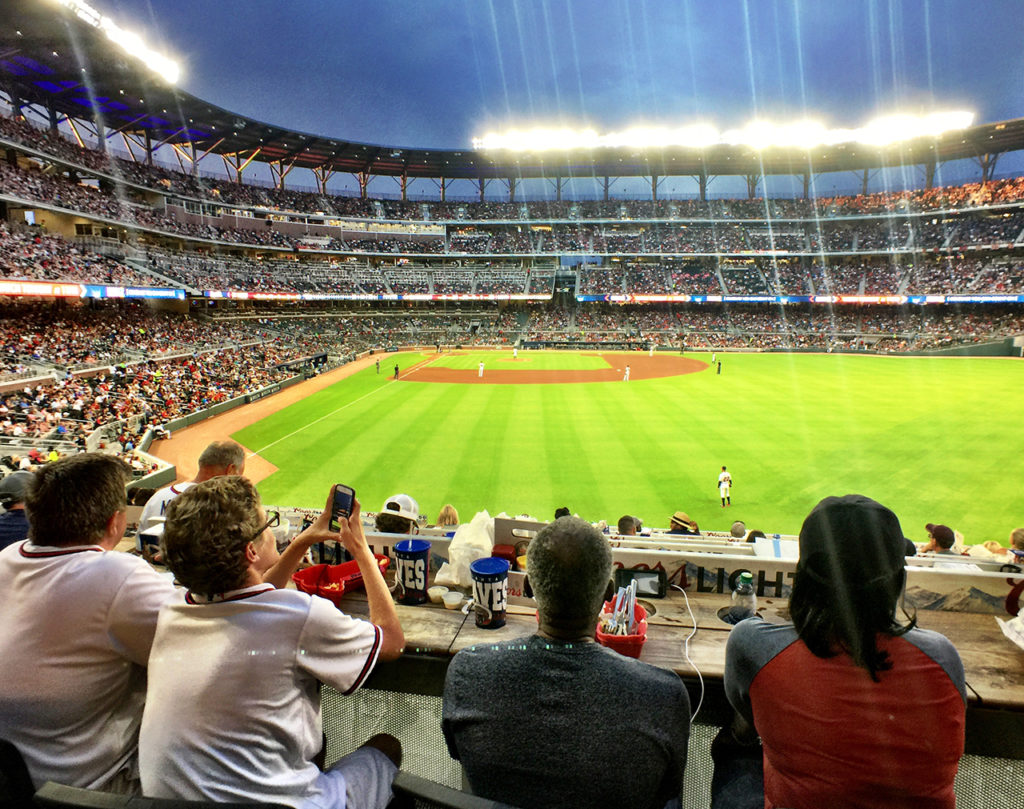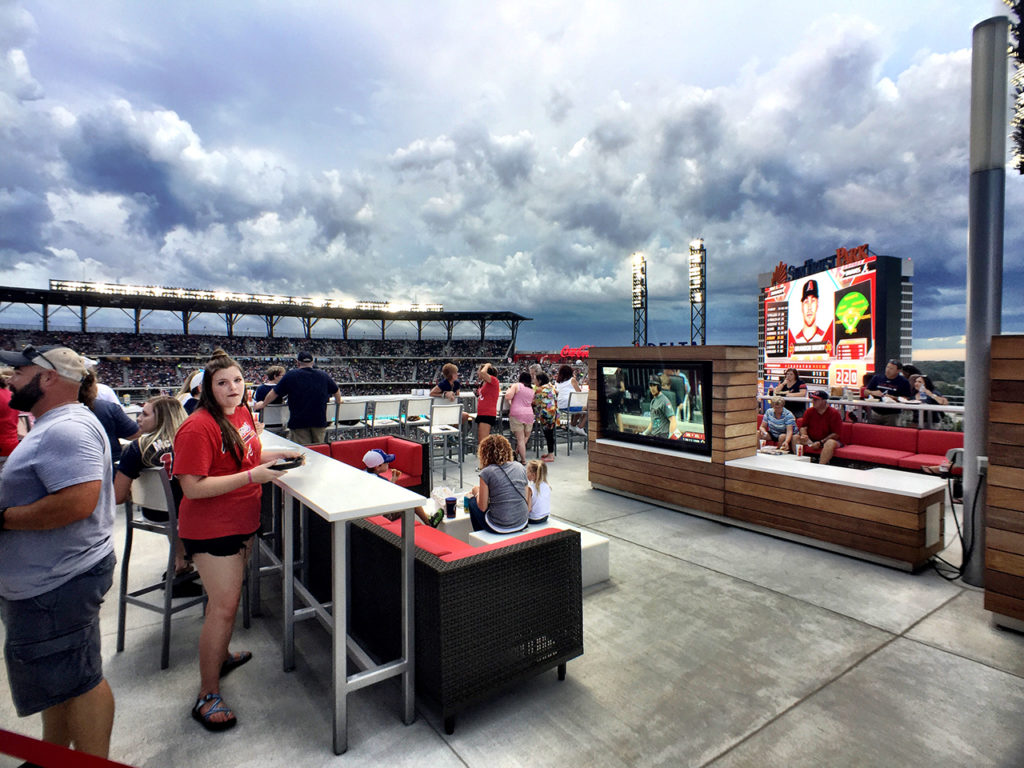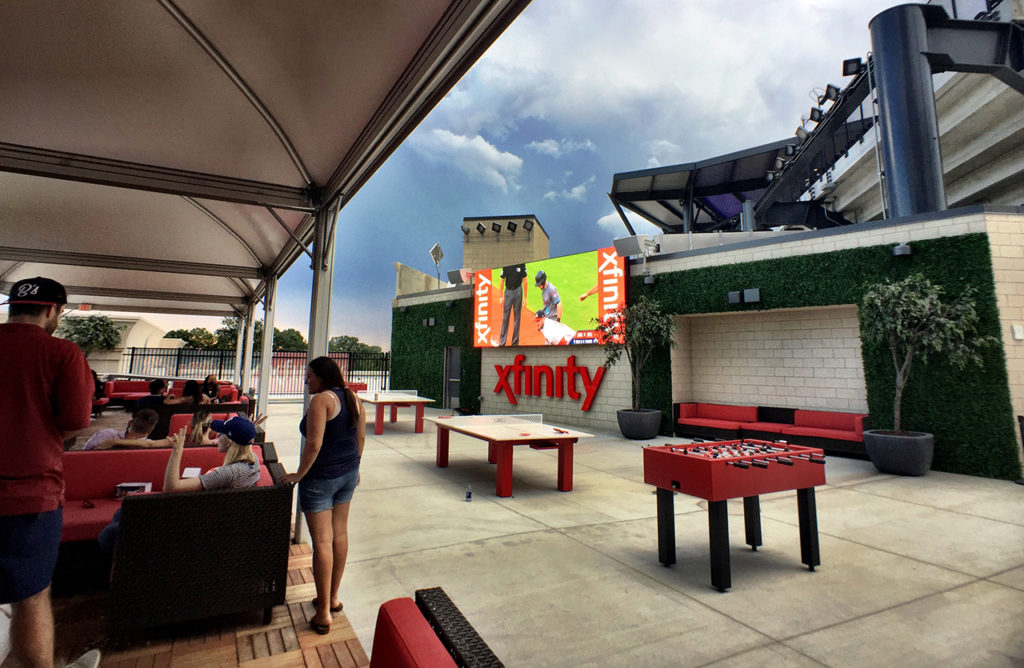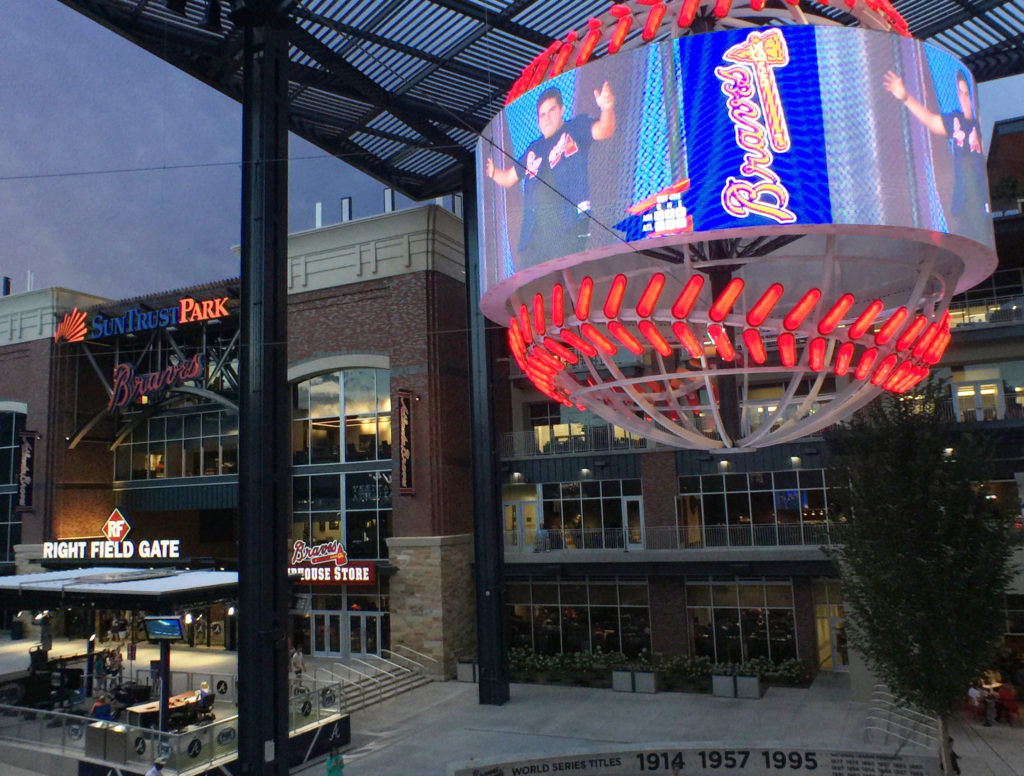As SunTrust Park continues to impress during its inaugural season, we dive deep into two big factors behind the Atlanta Braves‘ successful ballpark launch: How the team creates community both in the design of physical spaces and a connection to virtually unlimited cyber spaces via broadband and the cloud.
These days a ballpark isn’t just a place to watch a baseball game: it’s a place to gather with friends as well as a backdrop to project yourself across the world via Facebook, Snapchat, and Instagram. The best ballparks serve both the baseball purists glued to the game and the casual fans who move about and post selfies with friends. SunTrust Park excels in serving the needs of all kinds of fans.
With ballparks now sporting big pipelines for data, fans are able to share their experiences to anyone across the world. And with the configuration of discrete spaces for groups of all sizes, the Braves have created a social experience for every kind of fan. That social experience can be whatever the fan wants-an explicit goal of the Braves during the design of SunTrust Park.
Every top-notch sports organization is fostering social spaces these days, whether it’s the New York Yankees adding social spaces to Yankee Stadium’s center-field area or the Atlanta Hawks installing a court-level bar and social area to Philips Arena. We’re now in an era where fans come to the ballpark and expect to be roaming around. Heck, they may not even have a ticket to a seat after entering via a Ballpark Pass; they may just float from bar rail to bar rail-and in the case of SunTrust Park, maybe even spend a few innings at the adjoining Battery or downing a few at the Terrapin Taproom microbrewery.
Those trends are prominently displayed at SunTrust Park, where the Braves and architect Populous succeed by creating spaces designed for small groups, while creating tools to connect us to the larger crowd.
When SunTrust Park opened, we focused on the design side of the equation and the many food and beverage options at a Braves game, while Populous’s Joe Spear presented an overview of hospitality as central to the SunTrust Park design.
Four months after the ballpark opening, we’re seeing fans settle into early habits. At a Friday night with over 41,000 fans in SunTrust Park, the ballpark never felt packed, as attendees were spilling into the ballpark social spaces and the adjoining Battery. Today you can’t design a new sporting facility without focusing on social spaces, and there are plenty within SunTrust Park. An illustrative example: fans hanging out on the upper-level cabana social space, all on their smartphones and watching the game on a videoboard. Closer to the action was another group space complete with patio furniture, four tops and game monitors. The popular Waffle House stand attracted fans to the area, while a modified Airstream trailer served drinks and more.
A decade ago, this would have been dead space at a ballpark. Today, these areas were in heavy use, thanks to some smart design and the emergence of heavy smartphone use at a ballgame.
“People are coming to live sports differently,” said Greg Mize, Digital Director for the Braves. “We’re trying to reach as many different kinds of fans as possible.”
The Braves do reach out to fans by supporting the official MLB apps, but count on fans telling their game stories themselves with Facebook, Twitter, Instagram and Snapchat. The MLB Ballpark App works well in pointing out social spaces and potential specials. For those buying parking at a game, the Waze app guides fans on their most efficient path directly to a parking-ramp or parking-lot entrance.
“These tools put the power in their hands,” Mize added. Ask the Braves, powered via Satisfi and MLBAM, lets fans ask questions answered by a bot-where is the nearest restroom, what is served in the nearest concession stand, etc. And the Braves also actively solicit both positive and negative feedback via the Ballpark app: “We try to turn a negative into a positive,” Mize added.
All this is made possible with a network billed as one of the most robust systems in all of professional sports. On an average gameday, 10,000-14,000 concurrent users access the Braves WiFi system. That’s not close to capacity or even straining the system, according to Braves Senior Director of Information Technology Greg Gatti: the dual 100GB of bandwidth (totaling 200GB, via 2 terabit ports) is enough for everyone in a sold-out ballpark to simultaneously post a selfie. On a Friday or Saturday with big crowds, the system is pushing 8.3 terabits of data, he added. Interestingly, more data is being uploaded than downloaded, indicating plenty of selfies and game updates are being submitted to Instagram, Facebook and Snapchat.
Installed through a partnership with Comcast Xfinity–Comcast, of course, is a major tenant in the adjacent SunTrust Park office development and will eventually host 1,000 employees in the new office space–the system was designed for future growth as well.
“When the ballpark opened, I saw a fan watching Cool Runnings on his phone while also watching the game,” Gatti said. “He was testing the bandwidth, and it passed with flying colors.”
All in all, SunTrust Park features 250 miles of single mode fiber optic lines, 500 miles of CAT6A lines, and 1,350 802.11ac access points: 900 in the ballpark, 450 in the adjacent Battery. A fan is literally never too far away from a WiFi access point.
In an unusual twist, only 5 GHz service is offered at the ballpark; there’s no 2.4 GHz service for slower, older devices.
“We offered the 2.4 GHz service for our Yankees exhibition game and Opening Day,” Gatti said. “When we looked at the data, the slower service was not used that much. People trade in cellphones pretty regularly, and there are not many out there that are four to five years old.”
High-speed networking isn’t the only high-tech component to SunTrust Park. Some 1,350 Panasonic televisions are installed throughout the ballpark. A new Suite Control System allows access to ticketholders via scanner, with no attendants necessary. And 15 videodisplay kiosks on the concourses bring up-to-date ballpark information to fans.
With big pipes, the team will be able to offer expanded services in the future. For instance, Gatti can foresee better analytics, providing the team with more information about how those networking services are used. Plus, MLBAM has been pushing hyperlocation services as a way to precisely target fans once they’re in the ballpark. A fan walking by an underutilized concession stand may be pitched an offer on their phone, for instance.
According to Mize, the emphasis on social services made possible with robust bandwidth will position the team well for the future. The competition for fans isn’t pitching SunTrust Park against pro football at Mercedes-Benz Stadium or pro basketball at Philips Arena, he says.
“We don’t foresee a lot of overlap between our fans and the fans going to an Atlanta Hawks game,” he said. Instead, the competition is with other sorts of entertainment, such as movies, as well as social activities like a group meeting for dinner or a drink. Which is the challenge faced by every sporting venue in coming years-and a challenge addressed with an emphasis on social spaces backed with robust bandwidth.
This article first appeared in the weekly Ballpark Digest newsletter. Are you a subscriber? It’s free, and you’ll see features like this before they appear on the Web. Go here to subscribe to the Ballpark Digest newsletter.





